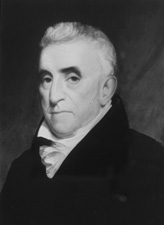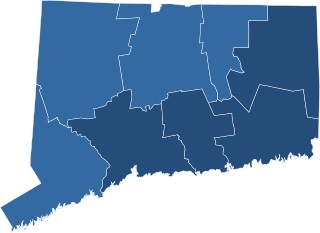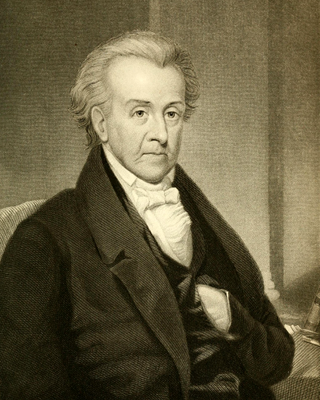
Presidential elections were held in the United States from November 4 to December 7, 1796, when electors throughout the United States cast their ballots. It was the first contested American presidential election, the first presidential election in which political parties played a dominant role, and the only presidential election in which a president and vice president were elected from opposing tickets. Incumbent vice president John Adams of the Federalist Party defeated former secretary of state Thomas Jefferson of the Democratic-Republican Party.

David Daggett was a U.S. senator, mayor of New Haven, Connecticut, Judge of the Connecticut Supreme Court of Errors, and a founder of the Yale Law School. He helped block plans for the first college for African Americans in the United States and presided over the conviction of a woman running a boarding school for African Americans in violation of Connecticut's recently passed Black Law. He judged African Americans not to be citizens and supported their colonization to Africa.

Oliver Wolcott Jr. was an American politician and judge. He was the second United States Secretary of the Treasury, a judge of the United States Circuit Court for the Second Circuit, and the 24th Governor of Connecticut. His adult life began with working in Connecticut, followed by participating in the U.S. federal government in the Department of Treasury, before returning to Connecticut, where he spent his life before his death. Throughout his time in politics, Wolcott's political views shifted from Federalist, to Toleration, and finally Jacksonian. Oliver Wolcott Jr. is the son to Oliver Wolcott Sr., part of the Griswold-Wolcott family.
The Toleration Party, also known as the Toleration-Republican Party and later the American Party or American Toleration and Reform Party, was a political party that dominated the political life of Connecticut from 1817 to 1827. The American name referred not to nativism or the later Know Nothing, which was also known as the American Party, but to the party's national orientation.
Elections to the Massachusetts Senate were held during 1788 to elect 40 State Senators. Candidates were elected at the county level, with some counties electing multiple Senators.

The 1827 Connecticut gubernatorial election was held on April 12, 1827. Former congressman, speaker and Democratic-Republican candidate Gideon Tomlinson defeated incumbent governor and Democratic-Republican candidate Oliver Wolcott Jr., winning with 56.71% of the vote.
Elections to the Massachusetts Senate were held during 1824 to elect State Senators. Candidates were elected at the county level, with some counties electing multiple Senators.

The 1826 Connecticut gubernatorial election was held on April 13, 1826. Incumbent governor and Toleration Party candidate Oliver Wolcott Jr. defeated former senator and Federalist Party candidate David Daggett, winning with 56.77% of the vote.

The 1824 Connecticut gubernatorial election was held on April 8, 1824. Incumbent governor and Toleration Party candidate Oliver Wolcott Jr. defeated former congressman and Federalist Party candidate Timothy Pitkin, winning with 88.81% of the vote.

The 1823 Connecticut gubernatorial election was held on April 10, 1823. Incumbent governor and Toleration Party candidate Oliver Wolcott Jr. won re-election with 88.96% of the vote.

The 1822 Connecticut gubernatorial election was held on April 11, 1822. Incumbent governor and Toleration Party candidate Oliver Wolcott Jr. defeated former congressman and Federalist Party candidate Zephaniah Swift, winning with 86.59% of the vote.

The 1821 Connecticut gubernatorial election was held on April 12, 1821. Incumbent governor and Toleration Party candidate Oliver Wolcott Jr. was re-elected, winning with 86.91% of the vote.

The 1820 Connecticut gubernatorial election was held on April 13, 1820. Incumbent governor and Democratic-Republican Party candidate Oliver Wolcott Jr. was re-elected, defeating Federalist Party candidates former delegate Nathan Smith and former congressman and state legislator Timothy Pitkin with 76.14% of the vote.

The 1819 Connecticut gubernatorial election was held on April 8, 1819. Incumbent governor and Democratic-Republican Party candidate Oliver Wolcott Jr. was re-elected, winning with 86.85% of the vote.

The 1818 Connecticut gubernatorial election was held on April 9, 1818. Incumbent governor and Toleration Party candidate Oliver Wolcott Jr. was re-elected, defeating congressman and Federalist Party candidate Timothy Pitkin with 86.32% of the vote.

The 1808 New Hampshire gubernatorial election was held on March 8, 1808.

The 1807 New Hampshire gubernatorial election was held on March 10, 1807.

The 1806 New Hampshire gubernatorial election was held on March 11, 1806.

The 1816 Connecticut gubernatorial election was held on 11 April 1816 in order to elect the Governor of Connecticut. Incumbent Federalist Governor of Connecticut John Cotton Smith won re-election against Democratic-Republican nominee and former United States Secretary of the Treasury Oliver Wolcott Jr..

The 1817 Connecticut gubernatorial election was held on 10 April 1817 in order to elect the Governor of Connecticut. Incumbent Federalist Governor of Connecticut John Cotton Smith lost re-election against Democratic-Republican nominee and former United States Secretary of the Treasury Oliver Wolcott Jr.




















